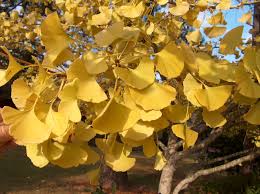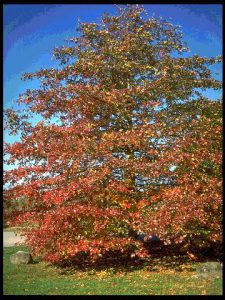Florida has so much to offer! It is home to the world’s most beautiful beaches. It has one of the largest agricultural economies nationwide.
But among all these things, Florida is lacking in one area that is very noticeable come fall: all the beautiful red, yellow, and orange leaf colors that paint the autumn landscape just a few hours to the north!
As frustrating as the lack of fall color in Florida’s native forests may be, this situation is easily amended in yards throughout the state by planting some autumn color standouts! Here are three of the very best for Northwest Florida:
- Ginkgo (Ginkgo biloba)
This holdover from the Jurassic Period (Literally! Fossil records indicate Ginkgo has existed virtually unchanged for well over 100 million years!) has much to offer as an ornamental tree, including spectacular golden-yellow fan-shaped leaves in fall! Somewhat ungainly in youth, a mature Ginkgo is truly a sight to behold, an 80-100’ tall, imposing specimen. Ginkgos are very tolerant of all soil conditions except waterlogged, have few insect and disease pests, and are remarkably drought-tolerant once established. Be sure to select a male cultivar however, as female trees produce extremely odiferous seeds that remarkably resemble rancid butter!
- Chinese Pistache (Pistacia chinensis)
A little-known, much underused tree in the Deep South, Chinese Pistache will light your landscape aflame with brilliant, orange-red fall foliage. One of the last trees to turn color in the fall, Chinese Pistache can help extend the show deep into November! It is a small to medium sized tree that will not overwhelm any but the smallest landscapes. As with Ginkgo, the habit of the tree in youth is awkward at best and the tree’s full potential is not realized until maturity when it becomes a dense, oval-round specimen. Chinese Pistache is close to bulletproof, tolerant of drought and poor soil conditions.
- Black Gum (Nyssa sylvatica)
One of Northwest Florida’s best native trees for fall color is Black Gum. Black Gum is a standout tree, pretty in all seasons, possessing dark, almost-black bark, a tall pyramidal habit and vivid fall foliage in the deepest shades of red and purple. As a bonus, Black Gum usually begins its color change very early, occasionally in September. The addition of this tree to a lawn dominated landscape can deliver at least an extra month of color! Black Gum prefers moist, deep soils but is found in dry flatwoods and swamps alike, betraying its adaptability.
Including the above trees in new or existing landscapes is an easy, smart way to extend the fall color show from September through November and make home gardeners long a little less for the colorful northern autumns! Happy Gardening!
- Tis the Season – Why Winter is the Best Time to Plant Trees and Shrubs - November 26, 2025
- Feeling Blue (Ginger) This Fall - November 13, 2025
- Lawn Care When It Just Won’t Rain - September 11, 2025



